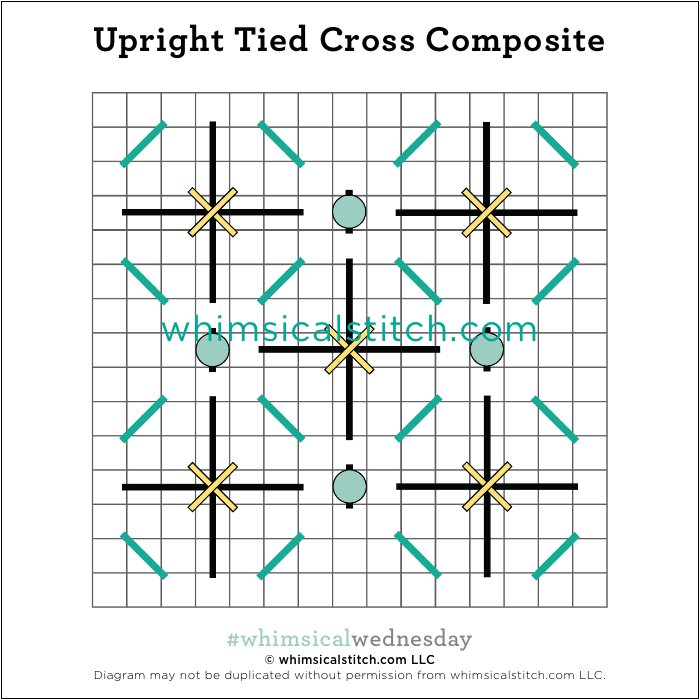Uneven split diamond ideas have been sitting in my needlepoint inspiration album for a few years. I’m kinda excited about the variation I ended up with. (And thank you to Patricia Sone for some of the original inspiration.)
The stitched sample is me playing with green Pepper Pot Silk (yellow lines) and four plies of blue Splendor (black lines) on 13M.
This sample screams fabric to me. I’m confident the color combination is an overwhelming component of that, but I would love to see this stitch as a bedspread or wallpaper/background. (It’s also possible the color combo was inspired by a Nordstrom window display I walked by this week.) There are way too many thread combos to choose from for those. Silk Lame (yellow lines) and silk floss (black lines) make sense to me for the bedspread. I would experiment with Flair (yellow lines) and a size 8 Perle Cotton (black lines) for a background. But! If the Flair goes rogue and spreads too much between the diamonds, I would change it to Neon Rays. And, if it’s Neon Rays, I would use a laying tool to make sure it stays flat and untwisted.
I would also consider ditching the yellow lines altogether. To glam it up a little bit, I would add five seed beads in the center of the diamonds. Add each seed bead over two rows on the vertical. The unevenness of the diamond centers would still be visible, but slightly less so. Also consider adding a bugle bead horizontally across the center for a more elegant bead addition.
Just a reminder about how to evaluate stitches for size on your project.
As you are auditioning stitches (from any stitch source), count the number of canvas threads on the diagram that match your mesh size. And there you have what an inch of the stitch will look like. Evaluate that against the area where you plan to use the stitch and make your final decision. If you start integrating this step into your stitch selection process, you may be surprised at how many stitches you think are large are much smaller than you realize. (Or, in today’s case, the stitch is much larger than it looks.)
By (sometimes) including this step in my own process, I find I am now integrating much longer stitches than I ever thought I would. I used to think a stitch six rows long was super big. I have very much changed my tune, which has helped me expand my creativity, especially for large-space stitches.
Today’s stitch diagram, along with all other #whimsicalwednesday and #smallspacesunday stitch diagrams, can also be found on a Pinterest board here. Be sure to follow whimsicalstitch.com on Facebook, Pinterest, Instagram, and Twitter.
If you like what you see on this blog, there's more. Mary’s Whimsical Stitches is a series of three books offering contemporary how-to collections of more than 250 stitches (in each volume) for all stitchers, regardless of skill level. All books include updated and sequenced diagrams from this blog plus a collection of all-new stitches from private lessons and other class projects. Visit here to find a needlepoint retailer that carries my books.
New to needlepoint or looking for a refresher? Please download a handy how-to guide covering basic needlepoint stitches and stitch compensation techniques along with new top-line information on needlepoint materials and tools, how to handle threads, and other helpful needlepoint resources.
whimsicalstitch.com also sells Stitch Guides and Stitch Concepts for Melissa Shirley Designs, Zecca Designs, Sandra Gilmore, Purple Palm, Maggie, and Penny MacLeod, and many more. Click here to see the newest guides and click here to see the entire collection.
I hope you have the perfect spot for this stitch! Please enjoy! Have a wonderful #whimsicalwednesday!
A Note about Diagrams
I use color in diagrams to make them as clear as possible. The primary function of different colored lines is to illustrate a stitch sequence. For example, the layering of colors demonstrates you add them in that order. They can also provide ideas on integrating additional threads (one line for each color). Or, you can use the same thread for all color lines. That's where I encourage you to use your imagination for the space you are stitching!













